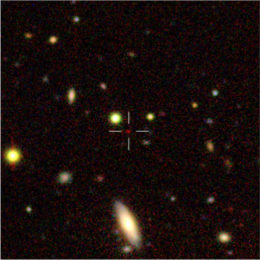Editor’s note: In these last two weeks of 2019, we’ll be looking at a few selections that we haven’t yet discussed on AAS Nova from among the most-downloaded papers published in AAS journals this year. The usual posting schedule will resume in January.
Discovery of the First Low-luminosity Quasar at z > 7
Published February 2019
Main takeaway:
A team of scientists led by Yoshiki Matsuoka (Ehime University, Japan) announced the discovery of the first low-luminosity quasar — a dim supermassive black hole actively feeding at the center of a galaxy — found at a redshift of z > 7. This redshift represents a time when the universe was still in its infancy, at less than a billion years old.

False color, composite image around the low-luminosity, high-redshift quasar J1243+0100, marked with the cross-hair. [Matsuoka et al. 2019]
Why it’s interesting:
By exploring distant quasars, we can learn about the conditions in the early universe, helping us to address questions like how the earliest black holes were able to grow to their enormous sizes in such a short time, or what sources were responsible for the majority of our universe’s reionization. Matsuoka and collaborators’ discovery is unique because, before now, the few quasars we’ve found at such high redshifts have been extremely luminous. Since we don’t think those sources are representative of the general population of high-redshift quasars, it’s exciting to now have a distant source to study that’s likely to be a more typical example.
How this quasar was spotted:
It’s hard to find high-redshift quasars — especially low-luminosity ones! — because their emission in observed wavelengths of less than 970 nm is almost entirely absorbed by the intergalactic medium. To discover them, you therefore need wide-field, deep imaging at wavelengths longer than this — which is exactly what the Hyper SuprimeCam on the Subaru Telescope in Hawaii provides. Matsuoka and collaborators conducted a broad survey, the Subaru High-z Exploration of Low-Luminosity Quasars (SHELLQs), which revealed not just the record-setting quasar detailed in this study, but also 82 additional, previously unknown distant quasars.
Citation
Yoshiki Matsuoka et al 2019 ApJL 872 L2. doi:10.3847/2041-8213/ab0216
